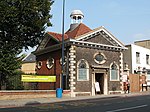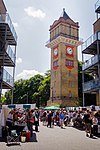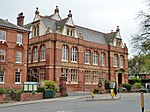Manor House Gardens

Manor House Gardens is a 3.34-hectare public park and gardens situated in Lee, in south east London. The park features a walled flower garden, ornamental pond, fountain, ice-house, cafeteria, children's playground, community garden, dog-walking area and tennis courts/multi-purpose sports pitches. There is also a Park Ranger's Office and information point adjacent to the cafe, and the River Quaggy flows from east to west across the southern part of the park. The gardens date from the late eighteenth and early nineteenth centuries and much of the original layout remains. The gardens feature a large central lawn with a peripheral path with trees and shrubbery. An ornamental pond at the southern part features a small island and fountain. The gardens are on the National Heritage List for England, Parks & Gardens.
Excerpt from the Wikipedia article Manor House Gardens (License: CC BY-SA 3.0, Authors, Images).Manor House Gardens
Brightfield Road, London Blackheath (London Borough of Lewisham)
Geographical coordinates (GPS) Address Nearby Places Show on map
Geographical coordinates (GPS)
| Latitude | Longitude |
|---|---|
| N 51.456 ° | E 0.006 ° |
Address
Brightfield Road 101
SE12 8QQ London, Blackheath (London Borough of Lewisham)
England, United Kingdom
Open on Google Maps







